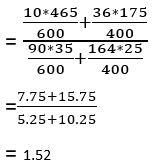Background Information
Confounding occurs in aetiological research when the relationship between a given exposure and a specific outcome is distorted/confused by the influence of a third variable/ group of variables- confounders.
Researchers aim to obtain an unbiased estimate of the causal relationship between exposure and outcome. They do so by controlling for confounding in the study design phase (by randomization, matching, and restriction) and/or during data analysis (by stratification, and multivariate analysis).
Stratification is a statistical technique that enables researchers to control for confounding by creating two or more categories (strata) in which the confounding variable either does not vary or varies very little.
There are two methods to adjust for confounding by stratification:
- Pooling analysis by the Mantel-Haenszel formula
- Standardization
Here, I will discuss the Mantel-Haenszel method in general and illustrate the same by showing how to calculate pooled Odds Ratio in Case-Control studies.
General notation of a 2×2 table:

Calculation of Odds Ratio:
Odds Ratio = a*d/b*c
Introduction
The Mantel-Haenszel formula allows calculation of an overall, unconfounded (adjusted) effect estimate of a given exposure for a specific outcome by combining (pooling) stratum-specific odds ratios (OR) or relative risks (RR).
Stratum-specific ORs or RRs are calculated within each stratum of the confounding variable and compared with the corresponding effect estimates in the whole group (that is, with the unstratified OR or RR).
When the effect estimates are roughly homogeneous across strata and do not differ from the whole group estimates, there is no confounding. When the effect estimates are considerably similar across strata but differ from the whole group estimates, confounding is present.
A RR or OR difference of more than 10% (between unstratified and stratified estimates) is considered as relevant to determine confounding. Percent difference is calculated using as:

The value thus obtained is expressed as a percentage (by multiplying by 100).
What information does the Mantel-Haenszel analysis provide?
- It provides statistical tests of whether the odds ratio are equal (homogeneous) or unequal (heterogeneous) across strata.
- It provides an estimate of the odds ratio of the exposure variable adjusted for the strata variable.
Assumptions
There are two basic assumptions when using this procedure:
- Observations are independent from each other: This means that each observation comes from a different subject, subjects were randomly selected from the population of interest, and no specific group of subjects was intentionally omitted
- All observations are identically distributed:
Steps for assessing confounding through the Mantel-Haenszel formula
There are five steps for assessing confounding through the Mantel-Haenszel formula:
- Calculate the crude OR or RR (that is, without stratifying)
- Stratify by the confounding variable and calculate stratum-specific OR or RR
- Assess the homogeneity of effect estimates across strata and compare stratified and unstratified ORs or RRs
- If there is homogeneity in effect estimates across strata then calculate the overall, adjusted OR or RR by the Mantel-Haenszel formula
- If there is heterogeneity and one is interested in effect modification, stratum-specific effect estimates should be reported separately.
Solved example
Let us consider the data from a fictitious study examining the association between obesity and cardiovascular disease (CVD):

Step 1: Calculation of Unadjusted (Crude) Odds Ratio
Odds Ratio for the above data is computed as
OR = ad/bc = (46*640)/(254*60) = 1.93
The unadjusted Odds Ratio indicates that there is an association between obesity and cardiovascular disease.
Step 2: Stratify by the confounding variable and calculate stratum-specific OR
The researchers observed that obese individuals tended to be older and suspected that age was a confounder. Therefore, they stratified the subjects by age:

Let us compute the stratum-specific Odds Ratio for each stratum (Age <50, and Age ≥50):
In the stratum Age <50 years Odds Ratio is: ad/bc = (10*465)/(90*35) = 1.47
In the stratum Age ≥50 years Odds Ratio is: ad/bc = (36*175)/(164*25) = 1.53
Step 3: Assess the homogeneity of effect estimates across strata and compare stratified and unstratified ORs
The Odds Ratio for each stratum is considerably lower than the unstratified (crude) Odds Ratio. However, the Odds Ratio for each stratum is similar. Thus, stratum-specific Odds Ratios are similar while unstratified Odds Ratio is higher than either stratum-specific Odds Ratio. This indicates the presence of confounding and is an appropriate case to apply the Mantel-Haenszel method.
Step 4: Calculation of adjusted OR by the Mantel-Haenszel formula
Mantel-Haenszel (Pooled) Odds Ratio is calculated by the formula:

Where ai, bi, ci, and di are the number of participants in the cells of the 2×2 table in the ith stratum of the confounding variable, and ni represents the number of participants in the ith stratum.
In the example above the Mantel-Haenszel (pooled) Odds Ratio can be calculated as:
Odds Ratio (Mantel-Haenszel)=


Note that the adjusted Odds Ratio is not equal to the unadjusted (crude) Odds Ratio. The adjustment for age yields an estimate of the Odds Ratio that is closer to the stratum-specific estimate (the adjusted estimate is a weighted average of the stratum-specific estimates).
Having obtained adjusted Odds Ratio we can now estimate the magnitude of confounding:

Thus, the magnitude of confounding due to age was 21%.
Summary
Confounding in research studies poses a threat to validity of results. It can be controlled in the analysis stage by calculating Mantel-Haenszel Odds Ratio (pooled Odds Ratio).
Useful Links and resources:
Links to articles on Mantel-Haenszel Method:


Pingback: Confounding versus Effect Modification: Essential differences | communitymedicine4all
How can I calculate adjusted crude ratio for a prevalence study having 11 cofactors?
LikeLike
Dear Olayinka,
Apologies for the delayed response. I am not sure I understand your question. Could you please rephrase it or provide additional details?
Thanks and regards,
Dr. Roopesh
LikeLike
Good stuff
LikeLike